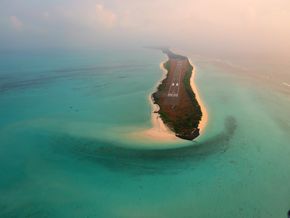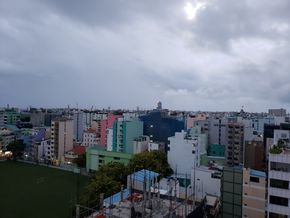Since 1972, the Maldives has been relying on tourism. It developed into the most important economic sector by the turn of the millennium. With a per capita income of more than US$ 7,000, the Maldives has since 2015 been considered a middle-income country. World Bank Director Faris Hadad-Zervos highlighted in a blog that tourism and related services contribute to about 40 percent of the Maldives' economic output and 80 percent of its exports.
To better distribute the income from tourism, guesthouses on inhabited islands have since 2009 been allowed to host guests. Previously, tourist accommodation was allowed in resorts only. Today, guesthouses account for about one fifth of bed capacity.
Many Maldivians rely on supplying vegetables, fruits, fish, and construction materials and on rendering a variety of services for their livelihoods. More than 60,000 mostly Bangladeshi migrants work in construction, tourism and fishing. They struggle for minimum wages which they have so far been denied.
Tourism as a vulnerable sector
The Maldives has been aware of tourism’s vulnerability to external shocks not just since the gross domestic product (GDP) declined by 29 percent in 2020 due to the Corona pandemic. After the tsunami in December 2004, economic output plummeted by as much as 62 percent.
The current crisis due to the war in Ukraine has less impact on tourist arrivals and on the GDP they generate in the Maldives. Tourism in the Maldives has always been high-end tourism. Price increases here do not necessarily lead to reduced demand. The arrival statistics for 2022 up to the month of October show that affluent Indian and Chinese tourists have replaced Russian and Ukrainian guests.
Investing in resorts in the Maldives remained a lucrative business, said a Male-based Australian tourism manager in a telephone conversation on the current situation. The return on investment was fantastic, despite corruption and high licence fees.
Drivers of debt
From the outset, tourism has been financed by loans. The government wanted to improve the conditions for further growth by expanding the infrastructure. However, the country’s debts increased disproportionately compared to its economic growth.
Since democratisation in 2008, the government has shown increasing commitment in social policy. Water supplies, postal services, telecommunications, power generation, ports and airports are all in the hands of state-owned enterprises, with the state remaining liable to cover their deficits.
Chinese and Indian loans
In 2013, the authoritarian President Abdullah Yameen took advantage of China's willingness to provide loans. He expanded the airport in Hulhumale and built the Chinese Friendship Bridge between Male and Hulhumale.
Elected in 2018, the more democratic President Ibu Solih made a geopolitical realignment by turning towards India, but still took additional loans from China which amounted to US$ 172 million in 2019/20.
High repayments
Even before the pandemic, the government was faced with high repayments of loans that fell due. It then also had to stabilize the economy and ensure supplies for the population during the pandemic. Credit lines of US$ 800 million and US$ 750 million were agreed with India in 2018 and 2020 respectively. The Ministry of Finance began to issue more government bonds on the financial market. Between 2010 and 2020, the total debt burden increased by 220 percent while economic output increased by just 145 percent.
Fortunately, the Maldives was able to benefit from the G20’s Debt Service Suspension Initiative and from special repayment terms for Chinese loans, introduced because of the pandemic. However, one billion US-dollars will be due for repayment by 2026.
The credit rating agency Fitch has pointed out that foreign currency reserves fell to 540 million in September 2022 from one billion US-dollars in September 2021 – a result of the global increase in prices of food and energy, which the Maldives need to import. This is one of the reasons why in October 2022, Fitch revised the Maldives' rating outlook to "negative" from "stable". Finance Minister Ibrahim Ameer and President Solih, however, rely on a forecasted economic growth of ten percent in 2022 and a GDP of 6.5 billion US dollars predicted for 2023. The government expects to service its debts on time, as it used to.
Climate change
As a result of rising sea levels, the approximately 580,000 inhabitants of the more than 1.200 islands are in danger of losing their homes. Almost all of the islands are facing erosion. Shoreline stabilisation and land fillings are costly. However, in the 2022 budget only 61 million US dollars have been earmarked for environmental protection. About one-third of this amount is reserved for the recycling island Thiulafushi to handle the large amount of garbage which is estimated to be around three kilos per tourist per day.
The eco-tax of six US dollars per tourist per day, introduced in 2015, generates revenues of about US$ 60 million per year on average. Since 2020, however, this money has been used to stabilise finances rather than to fund environmental projects and sustainable energy. Only four percent of the energy produced is from sustainable sources; diesel generators produce electricity. Many of the costs associated with tourism are externalised – in the form of environmental damage, poor working conditions, low wages, and a lack of social protection of staff.
In an interview with the German magazine "Südasien" (“South Asia” – 3/2021), former president and climate activist Mohamed Nasheed urgently calls on Germany and the EU to achieve the Paris climate goals in time and to place a special focus on sustainable aviation. For the time being, he does not see any alternatives to tourism for his country either.
Peter Lanzet was Bread for the World's policy advisor on development finance and debt cancellation for 18 years and has since 2014 been in charge of the quarterly news from the Maldives for the German magazine "Südasien".
Translation: Christina Kamp


![[Translate to english:] Insel](/fileadmin/tourismwatch/_processed_/d/1/csm_shifaaz-shamoon-AAFH_AADpRg-unsplash_0_062d841152.jpg)


